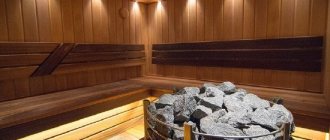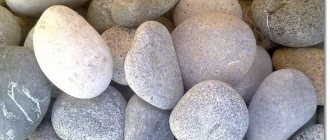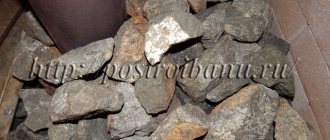A bathhouse is not just a place to relax, but a way to improve your health and well-being. If you choose the right stones for a bath, the beneficial vapors emanating from the hot stones will help cope with diseases and speed up recovery.
But buying to save money increases the risk that the stones will contain radioactive elements and other harmful particles that are life-threatening.
We will talk about all aspects of choosing the appropriate material for a sauna stove and sauna decoration in this article.
What properties should stones for a bath have?
To correctly determine which bath stones are suitable for your steam room, you should first understand the basic characteristics of these stones. They must have the following properties:
- Density. The heavier the stone, the more suitable it is for a bath or sauna.
- Heat resistance - the ability to experience systematic heating to very high temperatures.
- Heat capacity is the ability of a stone to store heat and smoothly release it into the environment. The greater the heat capacity of the rock, the longer the bath will remain heated.
- Environmentally friendly : when heated, the stone should not emit harmful substances.
- Uniformity of structure . It is not recommended to use stones with inclusions and veins in baths. Otherwise, heating will occur unevenly, which will quickly lead to destruction.
It is best to use stones with a uniform structure
- No cracks. You can check the stones by knocking them against each other. If everything is in order, the sound will be clear and clear.
There are two opinions about the size of the stones. Some people think that they should be the same size. Then the heater will heat up evenly and release heat evenly.
Others say that it is better to choose stones of different sizes. Moreover, the largest ones should be placed down, medium ones above, and small ones at the top. This is necessary so that the large lower stones store heat and retain it for a long time, releasing it a little at a time and maintaining the temperature of the rest of the heater.
There is no clear answer to the question of which stones are better for a bath, the same or different in size: both methods have proven themselves well.
Now about smooth and chipped stones. The first ones serve for a very long time, do not crack or delaminate. The latter give off heat more intensely due to their large surface area, but require frequent replacement. Here the choice is yours.
Heat exchange in crushed stones is more intense than in smooth ones
Before laying, stones can be tested for heat resistance. To do this, they need to be heated over a fire, and then immediately lowered into a bucket of cold water. If no cracks appear, then the stone will last a long time.
Origin
Amphibolites, which are of metamorphic origin and correspond to a medium degree of metamorphism, are most often found in folded belts (for example, in the Alps and the Ural Mountains) and in metamorphic Precambrian complexes (Ukrainian, Aldan, Baltic, etc.).
The formation of amphibolites occurs at temperatures exceeding 400 degrees Celsius and pressure capable of ensuring strong compaction of minerals: such pressure is possible only at depths equal to several kilometers from the Earth's surface.
Source breeds are presented:
- most often - igneous rocks of basic composition (they are called orthoamphibolites), sometimes - ultrabasic composition;
- tuffaceous-sedimentary rocks;
- marly sedimentary rocks (their synonymous name is paraamphibolites).
What types of stones are suitable for a bath?
Now let's talk about which stones are suitable for use in a bath or sauna, depending on their breed. Traditionally, everyone tries to choose natural samples, the shape of which was created by nature itself.
You can also find synthetic bath stones on sale, but it is worth remembering that they do not have any healing properties.
Jadeite and its unique properties
Greenish colored stone. Of all those used for laying the heater, it is considered the most beautiful. It belongs to semi-precious rocks, so it is expensive.
Jadeite is a very beautiful stone
In addition to appearance, jadeite has other advantages:
- High heat capacity . The breed retains energy for an amazingly long time.
- Healing vapors when heated. The stone has a beneficial effect on the genitourinary and endocrine systems, and also accelerates the blood.
- Low moisture absorption. Therefore, high-quality steam is released.
Since it is too expensive to lay the entire heater with this type of stone, you can buy several copies and place them at the very top. A kilogram of jadeite will be quite enough for a medium-sized bathhouse.
Doctors say that jadeite is suitable for those with joint problems. It emits positive infrared radiation, ionizes the air and enriches water with metasilicic acid. Therefore, jadeite is suitable for those who are thinking about the question of which stones are best for a bath in a steam room for health.
The healing properties of jadeite have long been proven
The service life of this breed reaches seven years. But after five years it begins to gradually lose its effectiveness.
Crushed jadeite is more suitable for a Russian bath. Due to its large area, it produces a lot of steam. Polished stones are best used in a sauna.
Soapstone for baths and saunas
Soapstone is a beautiful and durable gray stone. It heats up quickly and accumulates heat well. A heater made of this type produces light and pleasant steam.
But for those who are thinking about which stones to choose for a bath and are considering soapstone, it is worth remembering that this is a very dusty rock. Although the problem can be solved: before laying, all stones must be thoroughly washed and dried in the sun.
The homeland of soapstone is Karelia and Finland. Therefore, it is considered a classic sauna stone.
Soapstone - a traditional stone for saunas
See also: Catalog of stone bath projects
Raspberry quartzite
When thinking about which stones are best for a sauna stove, you should pay attention to crimson quartzite. The breed has a bright brown-purple color. It stores and releases heat well and does not absorb moisture. It is considered the most crack-resistant stone. You can even pour ice water onto a hot stove lined with crimson quartzite.
Scientists know a lot about the healing properties of crimson quartzite:
- Normalizes blood pressure and strengthens the circulatory system.
- Pain relief for joints.
- Treats migraines and helps with problems associated with weather changes.
- Regulates the functioning of the reproductive system.
Crimson quartzite is a beautiful red-brown stone.
But the most important quality of raspberry quartzite or porphyry, as it is also called, for a bathhouse is that it can produce light steam for a long time, even after the stove is stopped. Therefore, washing in such a steam room is easy and pleasant.
What other stones are suitable for a bath?
When talking about which stones are best for a steam bath, you should pay attention to the following rocks:
- White quartz is a translucent stone. It looks very impressive in the heater, because when heated it creates a glow, which is why it got the name “hot ice”. However, white quartz is fragile and unstable to high temperatures, so it is better to use it in open-type heaters. Although it is an expensive stone, it will not last long.
White quartz is a beautiful but short-lived stone
- Gabbro-diabase is a durable stone that accumulates heat well. In many ways similar to soapstone. But there is a big difference in price. Gabbro-diabase is much cheaper, so it is found in many steam rooms.
Gabbro-diabase - a budget option for a bath or sauna
- Basalt is a black stone. It lasts for a very long time, most likely the heater will not have to be updated until the very end of the bath’s operation. This is due to its high density and strength, low water absorption and resistance to sudden and frequent temperature changes. In addition, it has a surprisingly high heat capacity.
Basalt is popular among all fans of the Russian bath
See also: Catalog of companies that specialize in the construction of baths and related work
- Sea pebbles. Interested in those who are wondering which stones are suitable for a steam bath, but are willing to spend a small amount on the purchase. To lay the heater, you can only take samples that have not been in contact with sea or river water for a long time. The fact is that if the stone is not sufficiently dried, then when heated it will give off an unpleasant odor. The structure of “wet” stone is also more prone to cracking.
Sea pebbles are the most affordable stone for a bath.
The heater in the steam room can also be made of such rocks as:
- Neuritis
- Jasper
- Chromite
- Dunit
- Dolerite
- Granite
Selection of adhesive solution and grout
The adhesive for working with tiles in a bathhouse on a floor with a drain must be elastic. This way, the fixing layer between the tile and the base will maintain its integrity during thermal expansion from heating and cooling. The reliability of adhesion of materials depends on the adhesive properties of the adhesive composition. Porcelain stoneware is considered the weakest in this regard. To glue it, a solution with a peel strength of at least 28 kg/sq.cm is used.
Often, in the case of facing finishing, the installation of “warm floor” systems is provided. Here, the tile adhesive must have additional markings indicating the permissibility of joint use. The remaining requirements are general: resistance to variable operating conditions.
An example of polymer tile adhesive for a “warm” floor Source kraftvostok.kz
In addition to similar properties and resistance to abrasion, the grout must have good compatibility with the glue. It is also necessary to select the filling composition taking into account the permissible parameters of the seam: depth and width. As a rule, craftsmen consider materials from two series: based on cement binder or epoxy resin.
Is it worth collecting stones for a bath?
The question of whether it is possible to collect valuable and effective rocks worries many who wonder how to choose stones for a bath. After all, this is a real opportunity to save money and at the same time create a high-quality heater.
It is quite possible to collect stones for a bath with your own hands
Most often, a stone suitable for a bath can be found on the slopes of mountains, on the shores of seas or rivers. Moreover, everything found near fresh water bodies will be of higher quality than marine samples. Although both stones were subjected to long-term processing by nature, the influence of sea water has a detrimental effect on the strength of the rock.
But when collecting stones yourself, you need to remember that many rocks can only be mined industrially. For example, gabbro-diabase, quartzite and jadeite will not lie on the surface. Therefore, manual collection implies that you will have to use only those specimens that you can find.
At the same time, there are many specialized stores that sell any breed. Here you can decide which bath stones are best to buy with unlimited choice.
Often, balanced sets with certain properties are created from stones. In this case, it is quite possible to line 80% of the heater with pebbles collected by yourself, and the remaining 20% with purchased valuable rocks.
Specialized stores offer a large selection of bath stones
Place of Birth
Amphibolite crumbs
Since there are no large deposits of amphibolites in nature, their extraction (together with the host rocks, which are gneisses and granite-gneisses) is carried out either in separate small quarries, or is carried out simultaneously with the development of other minerals.
It is known that rubies, gold, titanium, rubies, garnets, vanadium and iron often occur next to amphibolites. In this regard, the market value of amphibolite raw materials increases significantly.
The main amphibolite deposits are located:
- In Karelia. The Nigrozero deposit is a supplier of valuable garnet amphibolite, marketed under the commercial names Nordic Sunset or Tundra. A subspecies of this mineral is also mined here, containing up to 70% white mineral inclusions, known as “Ice Tundra”.
- In the Urals. Local orthoamphibolites are associated with rich titanium deposits.
- In the Murmansk region (Musozero deposit).
- In the Yamalo-Nenets Autonomous Okrug (Amphibolite deposit, Kharp village).
- In the Arkhangelsk region (Pokrovskoye quarry).
- In the Eastern Sayan Mountains (Kruchininskoye, Lysanskoye, Malo-Tagulskoye deposits).
- On the territory of right-bank Ukraine.
How to lay stones in a stove
The heating rate of the heater directly depends on the installation method. A conventional stove for a Russian bath requires gradual, uniform heating. The heating process is a long-term operation, and active steam formation will begin after all the fuel has burned out. Proper placement of stones can significantly reduce the time it takes to get the steam room into working condition.
Proper installation of the heater is the key to quick heating
The two most important characteristics of bath stones are heat capacity and thermal conductivity. It is better to place stones that are more thermally conductive, but have less heat capacity, closer to the fire. This way heat will be transferred faster from bottom to top. This rule is especially relevant when using different breeds.
It is advisable to place stones of different fractions in the heater: the smaller, the higher. After all, the larger the stone, the longer and more intensely it needs to be heated. Small stones are necessary in order to create a large heat transfer area.
Smaller stones should be placed on top
Price
Amphibolite goes on sale in the form:
- Slebov (slabs). A standard slab 3 cm thick costs 4,000-5,000 rubles.
- Unedged and polished strips that have undergone heat treatment. The cost of a 2 cm thick strip is 2,000-3,000 rubles.
- Boulders intended for landscape design. They are used to decorate rockeries (small stone gardens) and rock gardens - compositions of plants and stones that imitate a mountain landscape, with the obligatory presence of a small reservoir. 1 kg of such stones costs at least 10 rubles.
- Crushed stone , the cost of which depends on the size of the fraction. Small stones are an order of magnitude cheaper than large ones. Crushed stone with a particle size of 5x20 mm costs about 1000 rubles per 1 m3, and screening 0x50 mm costs 150 rubles. For large crushed stone with a fraction size of 70x150 mm, the seller can charge about 600 rubles per 1 m3.
- Plates intended for the manufacture of monuments. Stones coming from Karelian quarries are in great demand among ritual offices. The cost of a slab measuring 60x50x5 cm is 4,000 rubles. Slabs more than 1 m high cost about 20,000 rubles.
Proper care of bath stones
Even natural stone, a seemingly very strong and durable material, becomes unusable after some time of use in extreme bath conditions. Over the course of a year, the heat output of the furnace can decrease by 15-20%.
Due to the constant high temperature, bath stones quickly lose important properties
It is recommended to carry out a complete inspection of the entire heater at least once a year. Damage, chips, cracks are a signal. That the stone needs to be changed. After inspection, it is advisable to rinse everything with clean running water. Every two years it is worthwhile to completely replace all the stones, however, if the sauna is used relatively rarely, then the service life can reach five years.
Benefits of use
Shungite finishing of the steam room allows it to have a comprehensive effect on the human body. A large amount of stone manifests itself under fallow as follows:
| Health sector | Sphere of cosmetology | Emotional sphere |
|
|
|
Energy experts also note that shungite consists of a certain spherical type of fullerene ions. It is these ions, in their opinion, that activate the body’s protective field from negative energies, electromagnetic radiation and vibrations.
With regular visits to shungite baths, the body’s energy comes into harmony, which has a beneficial effect on vitality and prevents the aging of spirit and body.
Video description
Here is an interesting video on how to wash stones for a bath:
In order for the steam room to function normally, it is necessary to correctly calculate the mass of the stones. It is believed that there should be 5-6 kg of rock per square meter. Then the desired effect and maximum durability of the heater will be achieved.
Different types of stone differ in their service life
For stoves with a closed heater, a type that is more resistant to high temperatures is needed. In open stoves, the heating is less intense, so deciding which stones are better for the heater in the bathhouse is much easier.
Features of installation work
With walls, the technological process is no different from installing cladding in any other premises. The surface must be strong, smooth and clean. The base is first pre-treated with preventive agents against fungus and mold, then impregnated with a moisture-resistant primer to ensure good adhesion to the glue.
Bathroom floors are more difficult to work with. The most important point here is the arrangement of natural drainage of water from the entire area indoors.
One of the schemes for arranging drainage from a bathhouse Source kanaliza.ru
Here are some solutions depending on the relevant conditions:
- a drainage embankment is installed under the subfloor - this is permissible in the case of highly absorbent soil, when the risks of freezing and heaving are eliminated;
- drainage is formed from pipes, trenches or through a pit - it is necessary in dense soil, on top of which water can accumulate;
- a storage well is installed to forcibly remove liquid - the only solution when it is not possible to drain water by other means from under the building.
The simplest option is to connect to a centralized sewerage system. Here it will be enough to lay and embed a separate channel into the main line. The connection to the latter is made through fittings and siphons, which prevent the reverse flow of wastewater.
After arranging the drainage or sewer system, you can begin to work on the rough foundation. Here it is important to provide a smooth transition of the platform towards the drain hole for the floor in the bathhouse made of tiles with a slope. There can be one or several points.
Example of drain hole design Source sanamore.ru
As a rule, a space is formed between the floor and the ground for natural ventilation through vents. The second common option is to form a cushion of compacted sand and gravel, which subsequently becomes the base for a concrete screed.
Briefly about the main thing
The main properties of stone for a bath are heat resistance, the ability to store heat and not absorb moisture, density and uniformity of structure.
- Jadeite is an expensive and rare stone that has a healing effect on the human body.
- Soapstone is a northern stone often used for saunas.
- Crimson quartzite is a beautiful brown stone that is resistant to high temperatures and produces high-quality steam.
To lay the heater, you can use gabbro-diabase, white quartz, sea pebbles, and basalt.
You can find some types of bath stones yourself. But you shouldn't do this on a railway embankment.
You need to place stones in the heater, placing them on the bottom. At the bottom there should be the most massive specimens and the most heat-resistant rocks.
It’s not enough to know how to choose stones for a bath; you also need to carefully care for them. Be sure to wash them and periodically replace damaged ones.
Ratings 0
Interesting Facts
- In the early Neolithic era, primitive tribes living in Central Europe hewed out their first tools from durable amphibolite - stone axes (choppers), hoes and digging sticks.
- English-speaking authors quite often call amphibolites any rocks of metamorphic origin whose chemical composition contains over 50% amphibole.
Contraindications
Visiting steam rooms with a stone can cause some harm.
Contraindications sound similar to the usual prohibitions on paired procedures:
- inflammation in the acute stage;
- epilepsy;
- severe cardiovascular problems;
- urolithiasis disease;
- hypertension;
- rehabilitation period after traumatic brain injuries, strokes, heart attacks.
There are also cases of reaction with poor health specifically to shungite finishing. If this is noted, you should stop the procedure and avoid this stone.











